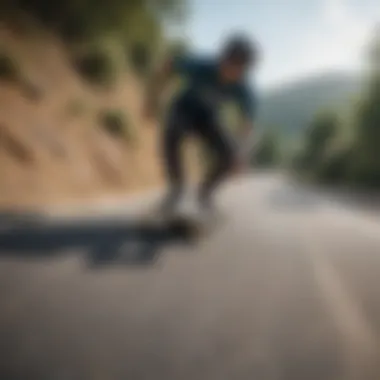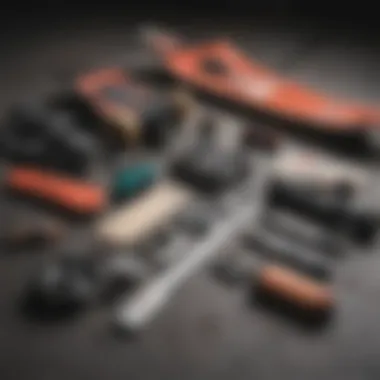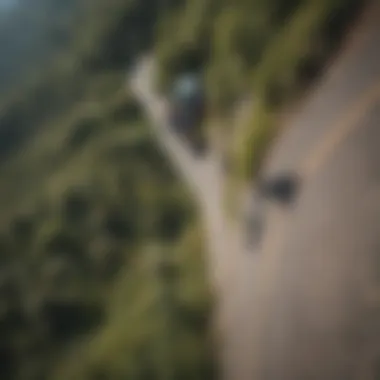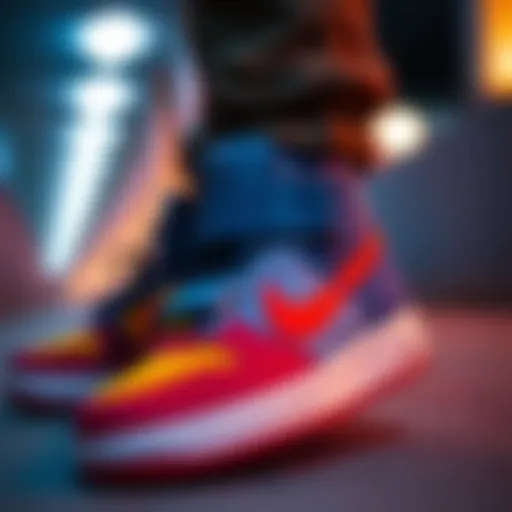Freeride Longboarding: Skills, Techniques, and Safety


Intro
Freeride longboarding is more than just a pastime; it's a vibrant culture and sport that demands finesse, control, and an innate appreciation for the wind whipping past. It began to see some traction in the late 20th century, mostly emerging from the fringes of skateboarding, where thrill-seekers sought a new way to push boundaries and explore the outdoor landscapes. Riding downhill at breakneck speeds, performing slides, and weaving through tight corners became part of the allure for many enthusiasts.
In its essence, freeride longboarding serves as a canvas for skill, where each rider’s choice of tricks and technique often reflects their personal expression. Whether you’re a seasoned skater carving smooth lines through city streets or a beginner just getting your bearings, there's something invigorating about the rush of riding with abandon. This article aims to unravel the intricacies of freeride longboarding, shedding light on both its heritage and the modern innovations that shape it today.
We will explore Skills Development, focusing on both foundational and advanced techniques for mastering the board. The section on Gear and Equipment will help you navigate through essential choices—everything from selecting the right skateboard to ensuring your safety with proper gear. We'll also share crucial tips that promote responsible riding practices, essential for ensuring that the rush of the ride does not overshadow safety. Along the way, our target audience of skaters, coaches, parents, and educators will benefit from comprehensive insights designed to enhance their understanding and experience in this thrilling sport.
So, buckle up and get ready to see freeride longboarding through a new lens. Whether you’re here to learn, enhance your skills, or understand how to stay safe, you’re on the right track.
Understanding Freeride Longboarding
Freeride longboarding is not just a sport; it’s a way for enthusiasts to embrace speed, skill, and the unique thrill of carving down hills and mastering slides. When you delve into the world of freeride longboarding, it’s crucial to understand how the foundations of this movement set it apart from other disciplines. This section informs not only individuals new to longboarding but also seasoned riders looking to refine their grasp on freeriding as a sport and lifestyle.
Definition of Freeride Longboarding
Freeride longboarding is characterized by a blend of artistry and athleticism, focusing on downhilling and performing tricks along the way. In its essence, this style incorporates various maneuvers like sliding, drifting, and carving through curves, with riders often prioritizing speed and fluidity over tricks like flips and grabs seen in freestyle longboarding.
A freeride longboard is specifically designed for high-speed descents and stability. This distinguishes it from other boards which might cater more to park tricks or cruising. Freeriding invites riders to express their unique style through flow and control, drawing on both technical skills and an understanding of the terrain.
History and Evolution
The roots of freeride longboarding can be traced back to the surfing culture of the late 20th century. As surfers sought land-based alternatives, they began adapting skateboards for their needs—what emerged was a mashup of surf techniques and skate innovations. Over time, this style evolved, with dedicated riders pushing its boundaries.
In the 1980s, longboards saw a resurgence fueled by the improved design and attention to performance, spearheaded by brands like Santa Cruz and Long Island Skateboards. As freeride began to carve its niche, competitions emerged, further defining what it meant to ride at high speeds while exercising technical prowess. The evolution continued into the digital age, where online communities and media spread knowledge and introduced newcomers to this exhilarating discipline.
Differences from Other Longboarding Styles
Understanding how freeride longboarding differentiates itself from other styles is key for anyone looking to engage in it. For instance:
- Freestyle Longboarding: This is more about tricks and stunts done on various terrains, focusing on creativity and innovation. Freeriders, however, center their performance around speed and slide mechanics.
- Downhill Longboarding: While freeride incorporates downhill runs, it allows for a mix of controlled slides rather than sheer speed as the only objective. Riders often these styles together when racing or in slalom settings.
Both styles may share equipment and techniques, but the main goal diverges: where freestyle is about aesthetic flair and agility, freeriding celebrates the rush of speed married to skillful maneuvering.
Freeride longboarding connects riders to their environment, enabling them to interact with landscapes in ways few other sports can. It's a fusion of adrenaline and artistry, perfectly illustrating how each curve of the road presents a new canvas for self-expression.
By immersing oneself in the mechanics and culture of freeride longboarding, you don’t just participate in a sport; you become part of a dynamic, ongoing celebration of skill, community, and personal growth.
Essential Equipment for Freeride Longboarding
In any sport, having the right equipment can make or break the experience. Freeride longboarding is no different. The joy of carving through city streets or gliding down hills is directly tied to the gear you choose. Selecting appropriate equipment is no small task; it affects everything from your balance to your speed. For those getting serious about freeride longboarding, understanding the nuances of the necessary gear enhances performance and safety.
Choosing the Right Longboard
When it comes down to it, the longboard is your main partner in crime. The right board can make the difference between a slick ride and a bumpy one.
Shape and Design Considerations
The shape and design of a longboard play a pivotal role in how you ride. Wide decks offer more stability, an essential feature for those who take to hills. On the other hand, narrower boards enhance maneuverability. A common choice among freeriders is the drop-through design, where the trucks are mounted through the deck. This design lowers the center of gravity, allowing for improved stability during high-speed runs. However, some might find that it's not the best for tricks.
Material Choices
Material is king in the world of longboards. Most boards are made from wood, bamboo, or composite materials. Wooden boards are durable but can be a tad heavy. Bamboo boards are lighter and offer great flex, which many riders appreciate. Composite materials can provide benefits like weight reduction and increased strength. Choosing a material often comes down to personal preference, but knowing the characteristics can help you decide what's best for your style and riding conditions.
Flexibility and Setup
Flexibility speaks volumes about how a longboard responds to your movements. A flexible board can absorb shocks better, making the ride smoother, especially on uneven surfaces. Conversely, stiffer boards provide better control at higher speeds, which is often a necessity for freeriding. When it comes to setup, the choice of trucks and wheels can impact how much flex you actually get. Remember, what feels great in a shop might feel different once you're out on the road.
Selecting Quality Trucks
The role of trucks cannot be overstated; they connect the wheels to your board and dictate how well you can maneuver. A good set of trucks balances strength with weight. When you ride with quality trucks, your steering becomes more responsive, and you’ll find your rides to be smoother. Pay attention to the width and height of the trucks, as these characteristics influence stability and how easily you can engage in sliding techniques. Choosing the right truck may feel bewildering at first, but spending time finding a set that suits your style will reward you with better performance.
Understanding Wheels and Bearings


The interaction between wheels and the surface affects your ride immensely. Getting the right wheels and bearings ensures you'll glide effortlessly through streets.
Diameter and Durometer
The diameter and durometer of wheels are critical in determining ride feel and performance. Larger wheels roll over cracks or rough patches more easily, making them great for downhill and freeride setups. Durometer, measuring hardness, affects grip and slide. Softer wheels might feel comfy but can slow down your speed. On the other end, harder wheels allow for a slicker ride but might have less grip. Finding a balance based on your skill level and terrain preferences is essential.
Bearings Types and Maintenance
Bearings might look minor, but their selection is significant. Precision bearings lead to faster speeds with smoother rides. Regular maintenance is key, though, as even the best bearings collect dirt and grime over time. Keeping them clean ensures longevity and performance. A well-maintained bearing can help you glide through your courses like a hot knife through butter.
Protective Gear Essentials
Safety should always come first. While the thrill of freeriding is massive, the risks can be equally great. Protective gear lessens those worries and offers peace of mind.
Helmets
A helmet is non-negotiable in freeride longboarding. A good helmet absorbs impact and protects your head during a fall. Look for a model that fits snugly but is also comfortable. Don’t shy away from investing in a solid helmet—it might just save your life during an unexpected spill.
Pads
Knee and elbow pads offer additional layers of protection, especially for beginners. They can cushion falls, allowing you to get back up with minor bruises rather than serious injuries. Many riders find pads cumbersome, but you might change your tune when you hit the pavement.
Footwear
Footwear impacts your connection to the board. Shoes designed specifically for skateboarding or longboarding provide grip and control. Look for features like a flat sole and good arch support to help with balance. Remember, what you wear on your feet can greatly affect your ability to perform techniques and remain comfortable over time.
Your gear is an investment in both performance and safety. Just like any sport, what works for one rider might not be the best fit for another. Experimentation is key to finding your ideal setup while prioritizing safety.
Fundamentals of Freeriding Techniques
The world of freeride longboarding is not complete without understanding the fundamentals of the techniques involved. Mastering these basics is akin to laying down the foundation of a house; without it, the higher structures wouldn't have the stability needed. Properly grasping these techniques enhances not only your performance but also your overall safety, making your experience on the board smoother and more enjoyable. Knowing how to balance your stance, carve effectively, control speed, and execute slides can radically affect your control on various terrains.
Basic Stance and Balance
Finding the right stance is the first step every newcomer must take. Positioning your feet in a way that optimizes balance while riding is crucial. Generally, this means placing your back foot over the tail of the board and the front foot somewhere between the front trucks and the nose.
Maintaining a low center of gravity while riding helps you manage the board better, especially during turns or abrasive terrains. It's about feeling connected to the ground; minor shifts in body weight can dramatically change dynamics when turning or stopping. Incorrect foot placement can lead to serious tumbles, and no one wants that!
Carving and Slalom Techniques
Carving resembles a dance on wheels, allowing riders to smoothly navigate turns with fluidity. The technique involves using your body to shift weight while leaning into the turn. Focusing on the rhythm of your movements can create a graceful carve, enhancing both speed and control.
When considering slalom, it’s a bit more intricate as it involves maneuvering around obstacles zigzagging down a slope. This requires rhythmic foot movements and a keen eye for upcoming changes in the pathway. Precision in slalom not only contributes to safety but instills confidence needed for trickier courses.
Drift and Slide Mechanics
Drifting involves intentionally losing traction on the board, creating a thrilling sideways slide. This technique can be particularly useful in downhill situations or when needing to adjust your path quickly. To initiate a drift, shift your weight to the rear of the board, pushing off using your front foot for balance. Mastering this maneuver not only helps you understand your board better but also teaches you essential control mechanisms.
Similarly, sliding requires precise mechanics—using the foot to brake while twisting the board parallel to the surface. A well-executed slide can turn an ordinary downhill ride into an exhilarating experience, making it a skill worth acquiring.
Speed Control and Braking Methods
Proper speed control is the crux of a safe riding experience. Riders need to be aware of their surroundings and understand how their speed is affected by terrain grades and surfaces. Effective techniques include foot-braking, which involves dragging the back foot along the ground, or using the tail of the board to slide.
A common mistake is to panic when approaching a slope; however, controlling your speed can often be as simple as shifting weight. Staying calm and using methods like carving can help maintain an even speed rather than slamming on the brakes. Knowing when and how to slow down can be the difference between a thrilling ride and a dangerous tumble.
"Mastering the fundamentals creates a powerful foundation for advanced techniques in freeride longboarding."
In essence, the fundamentals not only enhance skills but allow individuals to express themselves through freeride longboarding. Gaining proficiency in these areas sets the stage for a more exhilarating and secure riding experience.
Advanced Freeride Techniques
Advanced freeride techniques play a crucial role in enhancing a rider's overall experience and proficiency in longboarding. Mastering these skills not only elevates performance but also allows for a greater sense of control and creativity while riding. Riders who delve into advanced techniques can maneuver more fluidly and tackle complex terrains with confidence. This section focuses on key elements that lead to improvement, the benefits of honing these skills, and considerations for riders aiming to push their limits in freeride longboarding.


Power Slides and Slide Techniques
Power slides form the backbone of advanced freeriding, allowing riders to regain control at high speeds and seamlessly transition between maneuvers. A power slide is executed by shifting weight to the rear of the board while applying pressure to the rear wheels, effectively breaking traction.
To master this technique, consider the following:
- Positioning: Start by adopting a crouched stance, keeping your knees bent.
- Carving: Initiate a carve to set up for the slide, using your hips to guide the board.
- Slide Execution: Quickly shift your weight back while turning your front foot to assist in the rotation. This method engages your core, providing stability and control.
The importance of power slides can't be overstated. They are incredibly helpful for maintaining speed control while maneuvering through tight turns and navigating obstacles on your path. Riders who practice regularly can refine their slides, gaining a valuable skill set for various freeriding situations.
Fakie and Switch Riding Skills
Fakie and switch riding can seem intimidating for many riders. However, being comfortable on both your regular and switch stances adds substantial depth to your riding capability. Fakie riding involves riding backward, while switch riding is when riders ride in the opposite stance.
To get started:
- Positioning: Begin by practicing riding in your switch stance, adjusting your balance until it feels natural.
- Practice Turns: Incorporate basic turns while in this stance, allowing yourself to gain confidence.
- Gradual Progression: As you become more comfortable, try adding slides and tricks into the mix.
Riding fakie and switch not only expands your skillset but also enhances your adaptability when confronted with different terrains and conditions. It inspires confidence in recreational and competitive settings alike.
Technical Descents and Cornering
When it comes to technical descents and cornering in freeride longboarding, precision and control are paramount. The ability to navigate steep inclines and sharp corners requires practice and expertise.
Key elements include:
- Body Positioning: Lean into the turn while keeping your weight centered over the board. This action reduces the risk of losing balance.
- Speed Management: Approach corners with a controlled speed, applying the appropriate technique learned earlier, like power slides, to maintain stability.
- Reading the Line: Visualizing the path you intend to take is essential for technical descents; it helps you anticipate changes in terrain and adjust your technique accordingly.
These advanced skills are invaluable for riders who thrive on challenging paths, making the ride exciting while ensuring their safety.
Flow and Line Selection on Courses
Finding the right flow and line selection can make all the difference when navigating a course. A good line maximizes speed and minimizes obstacles, allowing for an efficient ride. The idea is to weave smoothly through turns and hills while maintaining momentum.
To enhance your line selection:
- Scout Your Course: Familiarize yourself with the terrain before diving in. Recognize key turns and potential hazards.
- Speed Control: Start at a speed that feels manageable at first, allowing you to focus on your line without overwhelming yourself.
- Smooth Transitions: Aim for fluid transitions between maneuvers. Avoid abrupt changes that can disturb your rhythm and balance.
"Finding your flow can turn a good ride into an unforgettable experience. Learn to read the course, and let intuition guide you."
Safety Considerations in Freeride Longboarding
Freeride longboarding can be an exhilarating way to experience the thrill of speed and skilled maneuvering. However, the freedom it offers comes accompanied by a set of risks, making safety considerations paramount. This section will delve into the numerous facets of safety that riders should keep in mind, highlighting proactive approaches that contribute to a rewarding — and secure — riding experience.
Understanding Risks and Managing Safety
Every sport carries inherent risks, and freeride longboarding is no exception. The most common hazards include falls, collisions, and loss of control, particularly on steep or uneven terrain. To effectively manage these risks, riders must develop a keen awareness of their surroundings and recognize the environment’s influence on their performance.
- Terrain Awareness: Before riding, familiarize yourself with the road or hill you plan to tackle. Watch for potholes, gravel, or unexpected changes in the surface.
- Traffic Considerations: Always be alert for vehicles in shared spaces. Riders should ideally choose areas with minimal traffic and respectful of road rules.
- Group Riding Dynamics: When riding with others, position yourself where you won't clash with fellow riders. Understanding how they maneuver can save potential mishaps.
- Skill Level Assessment: A rider must know their limits. It’s fine to push oneself, but understanding what one can handle can prevent serious accidents.
To further amplify safety measures, a fundamental approach is to practice stops and to slow down gradually when needed. A well-placed foot on the ground can do wonders when precision control is required.
Importance of Wearing Protective Gear
Wearing protective gear is like wearing a seatbelt in a car; it drastically enhances safety. Despite the temptation to ride without it for style, it's essential to prioritize your wellbeing.
- Helmets: A quality helmet can be a lifesaver, protecting the brain — one of the most vital organs. Ensure it fits well and meets safety standards.
- Padded Gear: Knee pads, elbow pads, and wrist guards can cushion the impact during falls. These may seem cumbersome, but they are worth the extra protection.
- Footwear: The right shoes can substantially improve grip and lower the risk of slips. Look for skate-specific shoes that provide both protection and performance.
- Reflective Gear: If you plan to ride at dusk or nighttime, wearing reflective items can significantly enhance visibility to others around, particularly drivers.
"Wearing protective gear isn’t just about avoiding scrapes; it’s about riding with confidence and peace of mind."
Safe Riding Practices and Etiquette
Riding safely also involves understanding etiquette and sharing the space with other users. Following a few simple practices can enhance the riding community's overall experience.


- Communicate: Use hand signals or verbal cues to inform other riders of your intentions. This could mean announcing a stop or indicating a turn.
- Respect Nature and Shared Spaces: If you’re riding in a park or a shared path, be courteous. Give way to pedestrians and avoid using spaces designated for foot traffic only.
- Avoid Reckless Behavior: Tricks and stunts may be impressive, but they can pose danger not only to you but to others nearby.
- Stay Mindful of Conditions: Weather can affect performance; slippery roads are no joke. Adjust your riding technique according to the weather for your safety.
In sum, safety in freeride longboarding is a multifaceted topic that combines awareness, preparation, and respect for oneself and others. By prioritizing these elements, riders can enjoy an exhilarating journey without undue risk.
Community and Culture of Freeride Longboarding
Freeride longboarding represents more than just a sport; it encapsulates a lively community bound by shared passion, skills, and experiences. The culture surrounding this thrilling discipline very much enhances the overall experience for riders, fostering connections that go beyond the mere act of skating. When skaters come together, they share not only techniques but also stories, philosophies, and inspirations that contribute to the unique vibe of freeride longboarding.
As a practice rooted in camaraderie, the collective energy propels riders into both personal and group progress. The learning curve, while steep, can be made smoother through the support and encouragement from fellow enthusiasts. Whether you’re a fledgling rider or have been carving hills for years, the opportunity to learn from one another can catalyze significant improvement in skills and confidence.
Freeride Events and Competitions
Freeride events are the heartbeat of the freeride longboarding community. They serve not only as platforms for competition but also as celebrations of the sport itself. These gatherings provide a chance for skaters to showcase their talents in a spirited environment, where tricks, slides, and speed take center stage.
In addition to the thrill of competition, events foster an atmosphere of excitement and encouragement. Competitors often cheer for each other, creating bonds common among riders despite varying skill levels. Events like Maryhill Freeride in Washington, for example, have become iconic in the community, attracting people from various parts of the globe. Such gatherings allow individuals to connect face-to-face, exchange tips, participate in workshops, and build friendships that can last a lifetime.
Influential Riders and Their Contributions
Several riders have etched their names into the fabric of freeride longboarding, inspiring newcomers and veterans alike. Figures like Brett Castro and Mason Maffucci have not only mastered the art of freeriding but also continually push the envelope of what’s possible on a longboard. Their unique styles, whether it be smooth flowing lines or aggressive slides, have captivated audiences and pushed many riders to refine their own approach.
But it’s not just about prowess on the board; these riders often engage with their fans through social media and video content, sharing insights into their training routines and techniques. This gives up-and-coming freeriders a firsthand view of the dedication and discipline required to excel in the sport. The impact of these figures resonates well beyond the competition space, as their philosophies about skating and life inspire a lot within the community.
Building a Supportive Freeride Community
Creating a nurturing environment is vital for the growth and sustainability of the freeride longboarding community. This involves encouraging experienced riders to mentor novices, and promoting inclusivity regardless of age or skill level. Many local groups on platforms like Facebook and Reddit act as safe havens for riders seeking advice or wanting to share their experiences.
Additionally, initiating community projects like local workshops or film nights can act as a catalyst for bringing people together. Regular meetups can provide opportunities for riders to practice together, helping them hone skills and boost confidence. While competitive spirit exists, it’s equally crucial that the community prioritizes kindness, respect, and mutual support.
As a whole, the culture of freeride longboarding is thriving, deeply rooted in collaboration and creativity. It’s about pushing boundaries and experiencing joy in the ride. For anyone involved, whether directly or indirectly, it’s a vibrant tapestry of experiences woven through shared passion.
Resources for Further Learning
In the world of freeride longboarding, expanding knowledge and skills is critical for anyone looking to deepen their riding experience. This section provides a curated list of various resources that can elevate both beginners and advanced riders. Whether it's books for theoretical understanding or hands-on tutorials from fellow riders, these resources are invaluable for honing techniques and gathering tips to improve your style. Moreover, engaging with a vibrant community enhances not just personal growth but also the joy of sharing this passion with others.
Books and Online Courses
Books and online courses serve as an excellent foundation for learning the intricacies of freeride longboarding. There are texts that delve deep into the physics of riding, techniques for executing slides, and formulating strategies for advanced maneuvers. They offer detailed insights that videos might overlook.
Some good titles include:
- "Skateboarding: the Ultimate Guide to Freestyle, Freeride and Downhill" gives practical drills and tips suitable for all levels.
- "Longboard Basics: A Beginner's Guide" covers essential skills and perspectives to ignite your enthusiasm.
Online courses, on platforms like Skillshare or Udemy, provide structured learning experiences. You can track your progress through lessons specifically tailored to freeride techniques, safety measures, and equipment choices. These courses often include feedback from experienced instructors, allowing you to get personalized advice that can be profoundly beneficial.
YouTube Channels and Tutorials
In today's digital age, YouTube acts as a treasure trove of knowledge. Numerous channels focus on freeride longboarding, covering everything from basic riding principles to advanced tutorials on how to perform complex slides.
For example:
- "The Bouncing Mantis" features engaging content on how to improve slide control and maintain balance. The instructor's casual yet informative style captures the essence of freeriding.
- "Board Blazers" shares tips and tricks from real riders, allowing you to see the techniques in action. Their tutorials break down each component into digestible pieces, making it easy for anyone to follow along.
These channels not only educate but also inspire you to get out there and ride. They often invite viewers to interact, share experiences, and ask questions, enhancing the feeling of community among riders.
Online Forums and Communities
Connecting with other enthusiasts is key in any sport, and freeride longboarding is no exception. Online forums offer a platform for skaters to discuss techniques, swap tricks, seek advice, or even organize meetups.
Subreddits like r/longboarding and dedicated Facebook groups bring together people from all levels of expertise to share their experiences, tips, and the occasional fun story. These interactives platforms might have threads dedicated to local spots for freeriding, allowing riders to discover fresh terrain in their area.
A few noteworthy online communities include:
- Longboard Planet - A site filled with resources and forums ranging from gear recommendations to event announcements.
- SkateLog Forum - A well-established forum that covers a broader spectrum of skating topics, including special sections for longboarders.
Joining these communities not only provides access to a wealth of knowledge but also fosters friendships grounded in a shared love for freeride longboarding. From casual exchanges to more involved discussions on gear and techniques, engaging with others can enrich your riding journey.
"In the end, the ride isn’t just about the tricks performed, but the journey shared with fellow riders who understand the thrill and creativity that comes with freeride longboarding."
By investing time in these resources, your understanding and enjoyment of freeride longboarding will certainly flourish, allowing you to ride with greater confidence and finesse.







